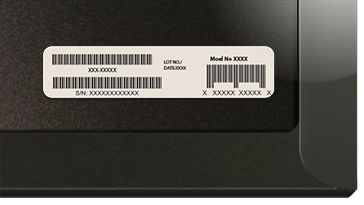Surface Serial Number Check
• • • Microsoft Surface is a series of and interactive whiteboards designed and developed. The devices are manufactured by and are designed to be premium devices that set examples to Windows OEMs. It comprises four generations of,, a convertible desktop, an, and various accessories all with unique form factors. With the exception of the first-generation Surface and Surface 2, all Surface PCs use processors and are compatible with Microsoft's operating system. The Surface family features six main lines of devices: • The Surface line of hybrid tablets, with optional detachable keyboard accessories, and optional. The latest model, the, uses an.

The serial number on the back of the Surface Pro/RT tablet under the kickstand. There is a Windows logo and two columns behind the kickstand. The right column is either 32GB or 64GB storage space, and the left column is the word “Surface” and the 12-digit serial number (look like XXXXXXXXXXXX.). You can find the model of a MS Surface by looking below the kickstand on the back. Everything you need is there, including tell-tale wording under the Windows logo, and the storage capacity. Model, Physical Attributes, Wording Below Logo. Surface Pro 2, • Black housing • 10.6' display, Windows 8.1. Surface 3, • Black.
• The Surface Pro line of professional hybrid tablets, use similar optional detachable keyboard accessories. The latest Surface Pro uses a 7th generation Intel Core series processors and does not include a stylus pen. • The Surface Laptop, a notebook with a 13.5-inch touchscreen. The device runs by default; however, it can be upgraded to Windows 10 Pro. • The Surface Book, a notebook with a detachable screen. The base is configurable with/without and an independently operable screen with support for the included stylus.
• The Surface Studio, a 28-inch that adjusts into a digital drafting table with stylus and on-screen Surface Dial support. • The Surface Hub, a touch screen interactive whiteboard designed for collaboration. Contents • • • • • • • • • • • • • • • • • • • • • • • • • • • • • • • • • • • • • History [ ] Microsoft first announced Surface at an event on 18 June 2012, presented by former in Milk Studios. Surface was the first major initiative by Microsoft to integrate its operating system with its own hardware, and is the first PC designed and distributed solely by Microsoft.
Olin Ross Or880 Manual. The first Surface device in the Surface line, was marketed as 'Surface for Windows RT' at the time was and was announced by, former President of Windows and Windows Live. The second Surface line, based on the Intel architecture was spearheaded with Surface Pro, marketed as 'Surface for Windows 8 Pro' at the time, and was demoed by Michael Angiulo, a corporate VP.
Sinofsky initially stated that pricing for the first Surface would be comparable to other ARM devices and pricing for Surface Pro would be comparable to current. Later, Ballmer noted the 'sweet spot' for the bulk of the PC market was $300 to $800. Microsoft revealed the pricing and began accepting preorders for the 2012 Surface tablet, on 16 October 2012 'for delivery by 10/26'. The device was launched alongside the of on 26 October 2012. Surface Pro became available the following year on 9 February 2013. The devices were initially available only at retail and online, but availability was later expanded into other vendors.
On November 2012, Ballmer described the distribution approach to Surface as 'modest' and on November 29 of that year, Microsoft revealed the pricing for the 64 GB and 128 GB versions of Surface with Windows 8 Pro. The tablet would go on sale on 9 February 2013, in the United States and Canada. A launch event was set to be held on 8 February 2013, but was cancelled at the last minute due to the.
The 128GB version of the tablet sold out on the same day as its release. Though there was less demand for the 64GB version because of the much smaller available storage capacity, supplies of the lower cost unit were almost as tight.
On 23 September 2013, Microsoft announced the and, which feature hardware and software updates from the original. The Surface 2 launched 22 October 2013, alongside the Surface Pro 2, four days after the general availability of. Later, Microsoft launched a variation of the Surface 2 with connectivity for the network on 18 March 2014. Microsoft then announced the redesigned on 20 May 2014, which went on sale on 20 June 2014. The following year, on 30 March 2015, it announced the, a more compact version of the Surface Pro 3.